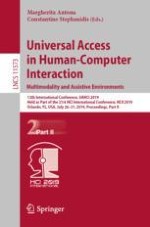2019 | Buch
Universal Access in Human-Computer Interaction. Multimodality and Assistive Environments
13th International Conference, UAHCI 2019, Held as Part of the 21st HCI International Conference, HCII 2019, Orlando, FL, USA, July 26–31, 2019, Proceedings, Part II
herausgegeben von: Dr. Margherita Antona, Prof. Constantine Stephanidis
Verlag: Springer International Publishing
Buchreihe : Lecture Notes in Computer Science
